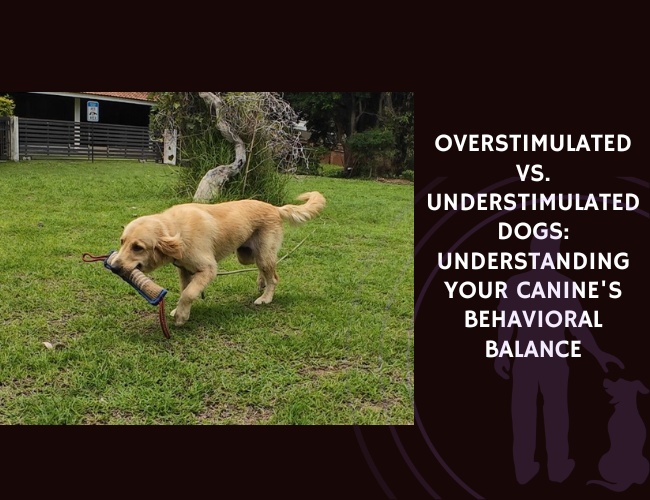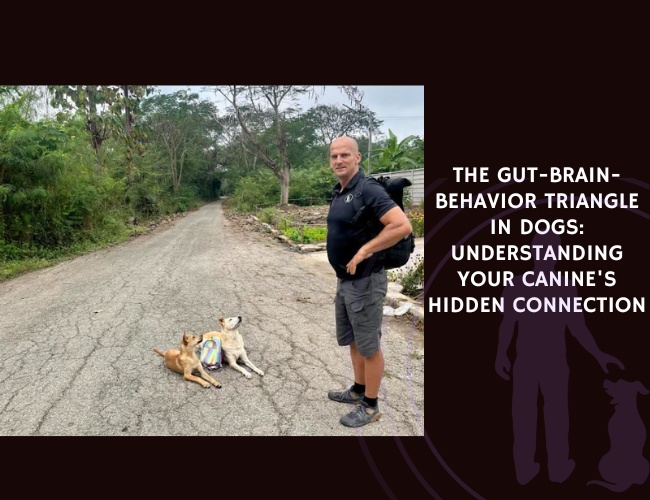The delicate balance between too much and too little stimulation shapes your dog’s daily experience in profound ways. Whether your furry friend bounces off walls or sleeps the day away, understanding their stimulation needs can transform their quality of life. Let us guide you through recognizing the signs, understanding the science, and creating the perfect balance for your beloved companion.
Why Stimulation Balance Matters More Than Ever
In today’s world, our dogs face unprecedented challenges to their neurological wellbeing. Unlike their ancestors who roamed freely and engaged with natural environments, modern dogs navigate a complex landscape of artificial stimuli, confined spaces, and human-centric schedules. This dramatic shift in lifestyle has created an epidemic of stimulation imbalances that affect millions of dogs worldwide.
The Hidden Crisis in Our Homes Many loving dog owners unknowingly contribute to their pet’s stimulation struggles. We’ve created environments that swing between extremes – from the chaos of family life with constant noise, visitors, and activity, to long stretches of isolation while we work. Neither scenario matches the balanced stimulation patterns dogs evolved to handle.
Consider how your dog’s day unfolds. Morning rushes with children getting ready for school, delivery trucks rumbling by, smartphones pinging, televisions blaring – then sudden silence for hours. This feast-or-famine approach to stimulation leaves dogs struggling to regulate their emotional and physical responses. The result? Behavioral problems that seem mysterious but actually stem from fundamental mismatches between what we provide and what our dogs need.
The Cost of Getting It Wrong When stimulation balance tips too far in either direction, the consequences ripple through every aspect of your dog’s life:
- Physical health suffers as stress hormones damage organ systems
- Mental wellbeing deteriorates, leading to anxiety or depression
- The human-animal bond weakens as behavior problems create frustration
- Learning capacity diminishes, making training feel impossible
- Quality of life plummets for both dog and owner
Yet with proper understanding and simple adjustments, these issues are entirely preventable. By learning to read your dog’s signals and create appropriate environments, you become their advocate for balanced wellbeing. The journey begins with recognizing that behavior problems often represent cries for help from an overwhelmed or underwhelmed nervous system. Your dog isn’t being “difficult” – they’re communicating the only way they know how.
Core Definitions: What’s Really Happening to Your Dog?
Understanding Overstimulation
When your dog experiences overstimulation, their nervous system becomes overwhelmed by excessive sensory input. Imagine trying to concentrate while sirens blare, lights flash, and people shout – that’s how an overstimulated dog feels. This sensory overload affects their ability to process information and regulate emotions effectively.
The Neurological Storm During overstimulation, your dog’s brain undergoes a cascade of neurological changes that fundamentally alter their perception and response to the world. The sympathetic nervous system activates, preparing the body for ‘fight or flight’. Blood flows to big muscles, the heart beats faster, pupils dilate, and the dog experiences an adrenaline rush. This ancient survival mechanism, while protective in true emergencies, becomes problematic when triggered by everyday stimuli.
The brain’s sensory processing centers become flooded with information they cannot adequately filter or prioritize. Special sensory receptors throughout your dog’s body – in their auditory system (hearing), olfactory system (smelling), visual system (seeing), and tactile sensory system (feeling) – all fire simultaneously, creating what researchers describe as a neurological traffic jam. Your dog literally cannot think clearly because their neural pathways are congested with competing signals.
The Hormonal Cascade Cortisol, the primary stress hormone, can increase by 207% in response to stress. This dramatic hormonal surge doesn’t just affect your dog momentarily – it can take up to 72 hours for cortisol levels to return to normal, which means it can trickle down into behavior for days. Understanding this timeline is crucial for managing your dog’s recovery from overstimulating events.
Beyond cortisol, several other hormones contribute to the overstimulation response:
- Adrenaline: Typically the first hormone released, adrenaline increases heart rate, blood pressure, and blood sugar while dilating bronchial tubes and pupils. This causes the characteristic panting you observe in stressed dogs.
- Chromogranin A (CgA): High reactivity in CgA levels 10 minutes after stress reflects an adaptive response, but elevated levels 40 minutes later indicate unsuccessful coping.
- Aldosterone: Affects blood pressure regulation and water balance, contributing to the physical symptoms of stress.
Physical Manifestations Overstimulation can lead to diarrhea, excessive salivation, tear production, rapid heart rate, central nervous system agitation, and neuromuscular dysfunction. These aren’t just behavioral issues – they represent genuine physiological distress that can impact your dog’s overall health.
Key markers of overstimulation include:
- Inability to settle or calm down even in quiet environments
- Heightened reactivity to normal stimuli that usually don’t bother them
- Emotional flooding that overwhelms their normal coping abilities
- Physical signs like excessive panting, trembling, or dilated pupils
- Difficulty processing familiar commands or cues
- “Shut down” behaviors where dogs become unresponsive
Sensory Sensitivity Variations Not all dogs experience overstimulation equally. Some dogs have sensory processing disorders or heightened sensitivity to certain stimuli, making them more prone to overstimulation. These sensitivities can be:
- Auditory: Extreme reactions to sounds others find normal
- Tactile: Defensive responses to touch or handling
- Visual: Overwhelm from movement, lights, or visual chaos
- Olfactory: Distress from strong or numerous scents
The Trigger Stacking Phenomenon Trigger stacking occurs when too many stimuli that the dog is sensitive to happen in a short period. This switches on the dog’s survival instincts, making them reactive. For example, a dog might handle the doorbell ringing OR a visitor arriving OR children playing, but all three occurring within minutes creates an overwhelming cascade.
When dogs face multiple stimuli they’re sensitive to, the negative feedback loop breaks down. Cortisol continues releasing, and up to four times normal cortisol levels can be present. This explains why a normally well-behaved dog might suddenly “lose it” after what seems like minor provocations – their system has been building pressure throughout the day.
Environmental Overstimulation Modern life presents unique challenges for our canine companions. Dogs were meant to live exposed to natural auditory stimuli like birds chirping, cows in fields, and night owls – sounds they can understand and categorize. Instead, they navigate:
- Constant electronic beeps and notifications
- Traffic noise and urban soundscapes
- Artificial lighting and screen flickers
- Chemical scents from cleaning products and air fresheners
- Unpredictable human schedules and activities
The Activity Paradox Interestingly, activities meant to tire dogs out can sometimes create overstimulation instead. For some dogs, playing fetch is too arousing. They show obsessive behavior about tennis balls, and 15 minutes of fetch becomes more overstimulating than exhausting. The cortisol produced during high-arousal activities can tip dogs into undesirable behaviors hours later.
Long-term Consequences Chronic overstimulation creates lasting changes in your dog’s neurology. The constant state of high alert exhausts their stress response system, potentially leading to:
- Increased baseline anxiety levels
- Reduced ability to cope with normal stressors
- Compromised immune function
- Digestive issues and food sensitivities
- Behavioral problems that become increasingly difficult to modify
Understanding these mechanisms empowers you to recognize overstimulation before it escalates. By identifying early warning signs and understanding the biological processes involved, you can intervene appropriately, creating a calmer, more balanced life for your beloved companion. Remember, what seems like “bad behavior” often represents a nervous system crying out for relief. 🐾
Recognizing Understimulation
Conversely, understimulation occurs when your dog lacks sufficient mental and physical engagement. This isn’t simply boredom – it’s a state of sensory deprivation that can profoundly impact their wellbeing. Dogs evolved as active, problem-solving creatures, and when these needs go unmet, their mental health suffers.
Signs of understimulation manifest as:
- Chronic lethargy and disinterest
- Seeking stimulation through destructive behaviors
- Development of obsessive habits
- Depression-like symptoms affecting appetite and social engagement
Individual Factors Matter
Your dog’s age, breed, and environment significantly influence their stimulation threshold. A Border Collie puppy requires vastly different stimulation levels than a senior Basset Hound. Young dogs typically have lower overstimulation thresholds due to developing nervous systems, while working breeds often need more enrichment to prevent understimulation. Understanding your specific dog’s needs forms the foundation of proper care. 🐾
Too Loud. Too Quiet. Just Right.
Overstimulation looks like energy—but it’s really overwhelm.
When your dog barks nonstop, jumps on guests, or zooms around the house like a live wire, it’s easy to label it excitement. But often, it’s distress disguised as drive. Their nervous system is flooded, their senses on overdrive, and their brain struggling to self-regulate. They’re not being “bad”—they’re overloaded.
Understimulation looks like calm—but it’s really collapse.
The quiet dog in the corner, the one who sleeps all day, who lost interest in walks or toys? That’s not peace. That’s withdrawal. Chronic understimulation wears down motivation, curiosity, and joy. When dogs stop asking for engagement, it’s not because they don’t need it. It’s because they gave up waiting.



Balance isn’t optional—it’s essential.
Your dog’s behavior is their language. Too much or too little input tips the scale toward anxiety, frustration, or numbness. The sweet spot? Structure. Predictability. Rest paired with challenge. Every dog needs a rhythm that matches their wiring. And when you find that rhythm, everything starts to work. 🧡
Observable Behavioral Patterns: Reading Your Dog’s Signals
When Overstimulation Takes Hold
You might notice your overstimulated dog displaying hyperactivity that seems uncontrollable. They may bark excessively at minor sounds, mouth or nip more frequently, or react dramatically to everyday situations. These behaviors aren’t defiance – they’re desperate attempts to cope with overwhelming sensory input.
Physical manifestations include:
- Inability to follow basic commands they normally know
- Escalated responses to minor triggers
- Difficulty disengaging from stimuli
- “Zoomies” that seem frantic rather than playful
The key distinguisher? Overstimulated behaviors feel chaotic and stressed rather than purposeful. Your dog isn’t choosing to ignore you – their overwhelmed nervous system simply can’t process your requests effectively.
The Quiet Crisis of Understimulation
Understimulated dogs often suffer silently. While overstimulation creates obvious chaos, understimulation manifests as withdrawal and disconnection. You might find your dog sleeping excessively, showing little interest in activities they once enjoyed, or developing repetitive behaviors like excessive licking or tail chasing.
Behavioral red flags include:
- Destructive chewing focused on household items
- Stereotypic behaviors (repetitive actions without purpose)
- Decreased social engagement
- Loss of training recall or learned behaviors
These symptoms mirror human depression because, neurologically, similar processes occur. Your understimulated dog isn’t lazy – they’re experiencing genuine psychological distress that requires intervention.
Neurological and Hormonal Mechanisms: The Science Behind the Behavior
The Overstimulated Brain
When overstimulation occurs, your dog’s hypothalamic-pituitary-adrenal (HPA) axis goes into overdrive. Cortisol and norepinephrine flood their system, creating a state of chronic stress. This hormonal cascade affects everything from immune function to cognitive processing.
The dopaminergic pathways – responsible for reward and motivation – become dysregulated. This means your dog struggles to find appropriate rewards in normal activities, leading to increasingly extreme behaviors as they seek regulation. Their amygdala hypersensitivity makes every stimulus feel threatening or overwhelming.
Understimulation’s Neurological Impact
Chronic understimulation creates a different but equally concerning neurological pattern. Dopamine levels plummet, reducing your dog’s motivation and ability to feel pleasure. This neurochemical depression affects their entire worldview – nothing seems interesting or rewarding.
Long-term understimulation can actually alter brain structure, particularly in areas responsible for learning and emotional regulation. The lack of appropriate sensory input during critical developmental periods can have lasting effects on cognitive function and behavioral flexibility.
Differentiating Between States: Diagnostic Approaches
Behavioral Assessment Strategies
Distinguishing between over- and understimulation requires careful observation across multiple contexts. Watch how your dog responds in different environments – does busy places overwhelm them, or do they seem more engaged? Document their reactions to various stimuli levels.
Assessment questions to consider:
- How does your dog behave after intense activity versus quiet periods?
- What triggers destructive behaviors – excess energy or boredom?
- When do problematic behaviors peak during the day?
- How quickly can your dog calm down after excitement?
The Role of Human Behavior
Your actions significantly influence your dog’s stimulation balance. Inconsistent training, unpredictable schedules, or mismatched activity levels can create either problem. Some owners inadvertently overstimulate through constant interaction, while others understimulate through benign neglect.
Consider how your lifestyle affects your dog’s experience. A high-energy owner with a sensitive dog might create overstimulation, while a sedentary lifestyle might understimulate an active breed. Matching your approach to your dog’s individual needs prevents both extremes.

Impact on Learning and Behavior: Long-term Consequences
How Overstimulation Impairs Development
Chronic overstimulation creates significant learning obstacles. Your dog’s overwhelmed nervous system can’t effectively process new information or retain training. They may appear to “forget” commands or struggle with impulse control despite previous success.
This state also lowers frustration tolerance, making everyday challenges feel insurmountable. Dogs may develop maladaptive coping strategies like excessive barking, leash pulling, or even aggression as they struggle to manage their overwhelmed state. Eventually, some dogs experience complete behavioral shutdown – a protective mechanism where they simply stop responding to stimuli altogether.
Understimulation’s Learning Deficits
Understimulated dogs face different but equally serious learning challenges. Without adequate mental engagement, neural pathways remain underdeveloped. These dogs often lack problem-solving skills and show poor generalization of learned behaviors.
The frustration from unmet needs can manifest as aggression or anxiety. Dogs may develop obsessive behaviors as they desperately seek stimulation, creating habits that become increasingly difficult to modify. Their cognitive flexibility suffers, making adaptation to new situations challenging.
Creating Balance: Practical Solutions for Your Dog
Addressing Overstimulation
Start by creating calm spaces where your dog can decompress. Implement structured downtime throughout the day, teaching relaxation as an active skill. Consider these strategies:
Environmental modifications:
- Designate quiet zones in your home
- Use calming music or white noise
- Limit visual stimuli with window coverings
- Create predictable daily routines
Training approaches:
- Practice “settle” commands in gradually busier environments
- Reward calm behavior more than excited behavior
- Build impulse control through structured games
- Implement regular decompression walks in quiet areas
Enriching the Understimulated Dog
For understimulated dogs, gradually introduce varied mental and physical challenges. Start small to avoid overwhelming them, then build complexity as they engage. Remember that mental stimulation often tires dogs more effectively than physical exercise alone.
Enrichment strategies:
- Puzzle feeders and interactive toys
- Scent work and nose games
- Training new tricks or behaviors weekly
- Rotating toys to maintain novelty
- Social interactions with compatible dogs
The key is finding activities that engage your dog’s natural instincts – whether that’s herding, hunting, or problem-solving. Match enrichment to breed tendencies for maximum benefit.
Lifestyle and Environmental Considerations
Creating an Optimal Home Environment
Your home environment profoundly impacts your dog’s stimulation balance. High-traffic areas might overstimulate sensitive dogs, while isolated spaces might understimulate social breeds. Consider your dog’s perspective when arranging living spaces.
Traffic flow, noise levels, and visual stimuli all matter. Some dogs benefit from elevated resting spots where they can observe without participating, while others need cozy dens for security. Pay attention to how your dog uses different spaces throughout the day.
Daily Routine Optimization
Establishing predictable routines helps dogs regulate their arousal levels. Structure provides security while preventing both over- and understimulation. Design routines that alternate activity and rest, ensuring neither dominates.
Balanced routine elements:
- Morning mental stimulation through training
- Midday physical exercise appropriate to breed
- Afternoon quiet time or gentle enrichment
- Evening social interaction with family
- Consistent bedtime wind-down routine
Special Considerations: Age and Individual Needs
Puppy Stimulation Requirements
Puppies face unique challenges with their developing nervous systems. They need careful stimulation that supports growth without overwhelming their limited processing capacity. Short, frequent enrichment sessions work better than extended activities.
Young dogs also require exposure to varied experiences during critical socialization periods. However, this must be balanced against their lower stress thresholds. Watch for signs of overwhelm and provide plenty of rest between new experiences.
Senior Dog Adaptations
Older dogs often need modified stimulation approaches. Physical limitations might reduce exercise capacity, making mental enrichment more important. However, cognitive changes can also lower their tolerance for complex challenges.
Adapt activities to match your senior dog’s capabilities while still providing engagement. Gentle scent work, modified puzzle toys, and social interaction often work well. Monitor for signs of frustration or fatigue, adjusting accordingly. 🧡
Conclusion: Finding Your Dog’s Perfect Balance
Understanding whether your dog experiences over- or understimulation empowers you to create their ideal environment. This isn’t about perfection – it’s about recognizing your individual dog’s needs and responding appropriately. Some dogs thrive with intense stimulation, while others flourish in calmer settings.
Watch for the signs we’ve discussed, consider the underlying neurological processes, and adjust your approach accordingly. Remember that needs change with age, health, and circumstances. What works today might need modification tomorrow.
Is your dog getting the stimulation balance they need? By observing carefully, responding thoughtfully, and creating appropriate environments, you can ensure your furry friend experiences the perfect balance between engagement and peace. Their improved behavior, enhanced learning, and overall wellbeing will reflect your efforts in creating their optimal life. 🐾










